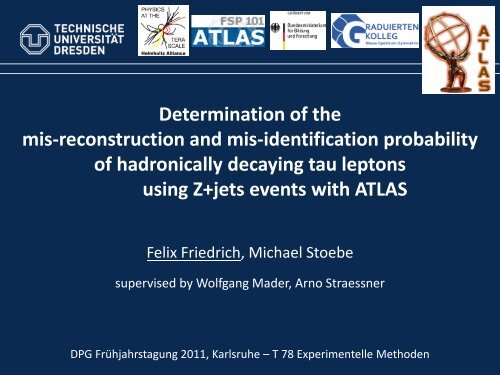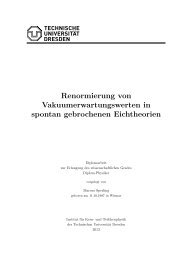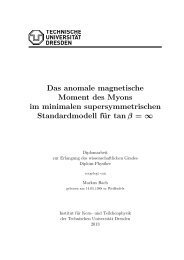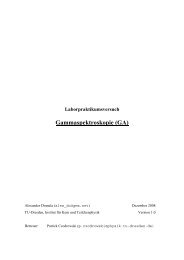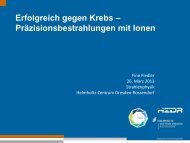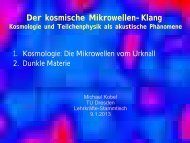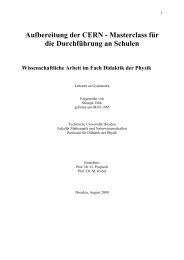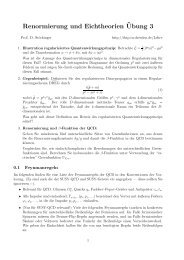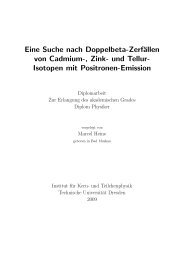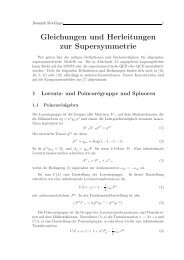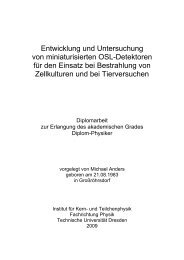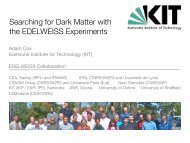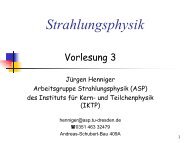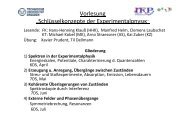Determination of the mis-reconstruction and mis-identification ...
Determination of the mis-reconstruction and mis-identification ...
Determination of the mis-reconstruction and mis-identification ...
Create successful ePaper yourself
Turn your PDF publications into a flip-book with our unique Google optimized e-Paper software.
<strong>Determination</strong> <strong>of</strong> <strong>the</strong><br />
<strong>mis</strong>-<strong>reconstruction</strong> <strong>and</strong> <strong>mis</strong>-<strong>identification</strong> probability<br />
<strong>of</strong> hadronically decaying tau leptons<br />
using Z+jets events with ATLAS<br />
Felix Friedrich, Michael Stoebe<br />
supervised by Wolfgang Mader, Arno Straessner<br />
DPG Frühjahrstagung 2011, Karlsruhe – T 78 Experimentelle Methoden
CERN / ATLAS<br />
Felix Friedrich (TU Dresden) tau fake rate studies<br />
geometrical distance<br />
between two objects:<br />
with pseudorapidity:<br />
Width: 44 m<br />
Diameter: 25 m<br />
Weight: 7000 t<br />
2 / 15
Motivation<br />
Many SM processes <strong>and</strong> searches for new physics have tau leptons in final state:<br />
SM processes with taus<br />
• Z � ττ<br />
• W � τν<br />
• Top-pair production<br />
Felix Friedrich (TU Dresden) tau fake rate studies<br />
Higgs boson / new physics search with taus<br />
• H � ZZ�4l • H ± � τ ± ν<br />
• H/A/h � ττ<br />
• Z’ � ττ • W’ � τν<br />
�for background estimation need to know number <strong>of</strong> <strong>mis</strong>identified tau leptons<br />
W� τν Z � τ(lep)τ(had)<br />
MSSM H � ττ<br />
Ref.: Observation <strong>of</strong> W->tau nu Decays<br />
with <strong>the</strong> ATLAS Experiment<br />
(ATLAS-CONF-2010-097)<br />
Ref.: Observation <strong>of</strong> Z->tau(had) tau(lep)<br />
Decays with <strong>the</strong> ATLAS detector<br />
(ATLAS-CONF-2011-010)<br />
Ref.: Data-driven background estimation for<br />
<strong>the</strong> H ->tau+tau- -> lh search at 7 TeV with <strong>the</strong><br />
ATLAS detector (ATLAS-CONF-2010-096)<br />
3 / 15
Tau <strong>reconstruction</strong> (hadronic decay mode)<br />
Calorimetry<br />
• seeded by calorimeter jets from topological<br />
clusters with E T> 10 GeV<br />
• collimated energy deposit in EM <strong>and</strong> Had<br />
calorimeters like QCD jets<br />
Tracking<br />
• well collimated collection <strong>of</strong> neutral <strong>and</strong> charged<br />
Pions <strong>and</strong> Kaons<br />
• mostly 1 or 3 charged tracks (prongs)<br />
leptonic decay mode is hard to distinguish from<br />
prompt electrons or muons<br />
� only hadronic tau decay mode considered<br />
Felix Friedrich (TU Dresden) tau fake rate studies<br />
4 / 15
Tau <strong>identification</strong><br />
τ <strong>identification</strong> tries to distinguish between<br />
tau jets <strong>and</strong> QCD jets<br />
various algorithms available:<br />
• cut-based<br />
• projective logarithmic likelihood (LLH)<br />
• Boosted Decision Tree (BDT)<br />
� 3 levels <strong>of</strong> efficiency available for each <strong>identification</strong> method:<br />
tight, medium, loose<br />
corresponding roughly to ~30%, ~50% <strong>and</strong> ~60%<br />
signal efficiency independent <strong>of</strong> E T<br />
� background is reduced by O(10-100)<br />
dedicated electron vetoes:<br />
• cut-based electron veto<br />
� available in tight, medium, loose<br />
• Boosted Decision Tree electron veto<br />
Felix Friedrich (TU Dresden) tau fake rate studies<br />
5 / 15
Tau fake rates from Z+Jets<br />
• select clean Z->ee/μμ + jets sample<br />
• use both leptons to tag event<br />
• mass window <strong>of</strong> 71 - 111 GeV for both channels<br />
• additional jets are used to test tau ID<br />
ATLAS work in progress<br />
invariant mass <strong>of</strong> tag muons invariant mass <strong>of</strong> tag electrons<br />
Felix Friedrich (TU Dresden) tau fake rate studies<br />
ATLAS work in progress<br />
l + l -<br />
QCD-Jet(s)<br />
7 / 15
Tau fake rates from Z+Jets<br />
fake rate for 3 different tau <strong>identification</strong> algorithms (medium efficiency)<br />
<strong>and</strong> medium electron veto<br />
ATLAS work in progress<br />
• lowest fake rate for<br />
Boosted Decision Tree algorithm<br />
• suffer from low statistics in high E T regions<br />
• flat in eta<br />
Felix Friedrich (TU Dresden) tau fake rate studies<br />
ATLAS work in progress<br />
fake rate is about<br />
• 8% for cut-based method<br />
• 3-5% for BDT <strong>and</strong> Likelihood<br />
8 / 15
Tau fake rates from Z+Jets<br />
ATLAS work in progress ATLAS work in progress<br />
ATLAS work in progress<br />
Felix Friedrich (TU Dresden) tau fake rate studies<br />
• no dependence on number <strong>of</strong> vertices<br />
• fake rate from Z->ee+jets <strong>and</strong><br />
Z->μμ+jets agrees within statistics<br />
• good agreement between simulation<br />
(MC) <strong>and</strong> data<br />
9 / 15
Differences di-jets vs. Z+jets<br />
• tau fake rate not equal in Z+jets <strong>and</strong><br />
QCD di-jets events<br />
• different fraction <strong>of</strong> quark <strong>and</strong><br />
gluon jets in both samples<br />
• quark jets are more tau like<br />
� higher fake rate<br />
Felix Friedrich (TU Dresden) tau fake rate studies<br />
MC Simulation<br />
ATLAS work in progress ATLAS work in progress<br />
di-jet selection:<br />
• select a well-defined di-jet<br />
topology by using a<br />
tag-<strong>and</strong>-probe method<br />
• balanced in phi <strong>and</strong> p T<br />
• probe jet is used to test<br />
tau <strong>identification</strong><br />
10 / 15
Estimate tau fake rate in di-jet events<br />
idea:<br />
• use tau fake rates from Z+jets events to estimate tau fake rate in QCD di-jet events<br />
problem:<br />
• tau fake rates from Z+jets events <strong>and</strong> di-jet events don’t agree sufficiently<br />
possible solution:<br />
• find variables which are sensitive to quark-gluon fraction<br />
• parameterize tau fake rate from Z+jets events in those variables<br />
• in di-jet sample: apply on every jet <strong>the</strong> fake rate coming from Z+jets<br />
but:<br />
• which variables to use?<br />
• limited statistics in Z+jets � only coarse parameterization possible<br />
• which ranges/limits for those parameterization?<br />
Felix Friedrich (TU Dresden) tau fake rate studies<br />
11 / 15
χ 2 - method<br />
� use simulated events<br />
� calculate fake rate for many variable combinations <strong>and</strong> ranges<br />
� separately for Z+jets <strong>and</strong> QCD di-jets<br />
� compare fake rates using a χ 2 - Test<br />
� use combination/ranges with best χ 2<br />
ATLAS work in progress<br />
Felix Friedrich (TU Dresden) tau fake rate studies<br />
blue: fake rate in di-jet events<br />
black: fake rate in di-jet events,<br />
where jets are weighted by a<br />
fake rate coming from Z+jets<br />
� agreement using data not sufficient<br />
still room for improvements<br />
12 / 15
Statistical method<br />
this method was developed <strong>and</strong> tested with tau <strong>reconstruction</strong> fake rate<br />
tau <strong>reconstruction</strong> fake rate is ≈ 1, due to tau <strong>reconstruction</strong> algorithm<br />
but in past two algorithms were used:<br />
� tau c<strong>and</strong>idates only considered if reconstructed by both<br />
� tau <strong>reconstruction</strong> fake rate < 1<br />
• use simulated events<br />
• select probe jets in Z+jets <strong>and</strong> QCD di-jet events<br />
• choose combination <strong>of</strong> 3 variables<br />
• divide phase space <strong>of</strong> those variables,<br />
so that each region has <strong>the</strong> same statistics for Z+jets <strong>and</strong> di-jets<br />
Felix Friedrich (TU Dresden) tau fake rate studies<br />
Michael Stoebe<br />
� asymmetric regions possible<br />
13 / 15
Statistical method<br />
ATLAS work in progress<br />
yellow:<br />
<strong>reconstruction</strong> fake rate in di-jet events<br />
black:<br />
estimated fake rate in di-jet events<br />
by using a fake rate coming from Z+jets<br />
Felix Friedrich (TU Dresden) tau fake rate studies<br />
Michael Stoebe<br />
� good agreement (2010 data)<br />
within statistical uncertainty<br />
was also tested on different event<br />
topology, like full hadronic toppair<br />
decays (only simulation)<br />
ATLAS work in progress<br />
MC Simulation<br />
14 / 15
Summary<br />
• tau <strong>identification</strong> fake rate determined for QCD jets in Z+jet events<br />
• various tau <strong>identification</strong> algorithms studied<br />
• fake rate depends on event topology<br />
� different in Z+jets <strong>and</strong> di-jet events<br />
� sensitive to quark/gluon contribution <strong>of</strong> probe jets<br />
• two different methods studied to estimate fake rate in di-jet events<br />
by using Z+jet events<br />
• both looks pro<strong>mis</strong>ing, but still room for improvements<br />
Felix Friedrich (TU Dresden) tau fake rate studies<br />
15 / 15
Backup<br />
Backup<br />
Felix Friedrich (TU Dresden) tau fake rate studies<br />
16 / 15
Tau <strong>identification</strong><br />
Variables used in <strong>the</strong> different tau <strong>identification</strong> algorithms<br />
Felix Friedrich (TU Dresden) tau fake rate studies<br />
ATLAS-COM-CONF-2011-057<br />
17 / 15
Tau <strong>identification</strong><br />
ATLAS work in progress<br />
ATLAS work in progress<br />
ATLAS work in progress<br />
ATLAS work in progress<br />
ATLAS work in progress<br />
ATLAS work in progress<br />
Felix Friedrich (TU Dresden) tau fake rate studies<br />
Variables used in <strong>the</strong><br />
different<br />
tau <strong>identification</strong><br />
algorithms<br />
ATLAS-COM-CONF-2011-057<br />
18 / 15
Tau <strong>identification</strong><br />
ATLAS work in progress<br />
ATLAS work in progress<br />
ATLAS work in progress<br />
ATLAS work in progress<br />
ATLAS work in progress<br />
ATLAS work in progress<br />
Felix Friedrich (TU Dresden) tau fake rate studies<br />
Variables used in <strong>the</strong><br />
different<br />
tau <strong>identification</strong><br />
algorithms<br />
ATLAS-COM-CONF-2011-057<br />
19 / 15
Tau <strong>identification</strong><br />
ATLAS work in progress<br />
ATLAS work in progress<br />
ATLAS work in progress<br />
Felix Friedrich (TU Dresden) tau fake rate studies<br />
Variables used in <strong>the</strong><br />
different<br />
tau <strong>identification</strong><br />
algorithms<br />
ATLAS-COM-CONF-2011-057<br />
20 / 15
Electron Veto<br />
Variables used in <strong>the</strong> cut-based tau-electron veto algorithm<br />
ATLAS work in progress<br />
ATLAS work in progress<br />
Felix Friedrich (TU Dresden) tau fake rate studies<br />
ATL-COM-PHYS-2011-188<br />
(will be changed in CONF number<br />
as soon as available)<br />
ATLAS work in progress<br />
ATLAS work in progress<br />
21 / 15
Electron Veto<br />
Variables used in <strong>the</strong> cut-based tau-electron veto algorithm<br />
Felix Friedrich (TU Dresden) tau fake rate studies<br />
ATL-COM-PHYS-2011-188<br />
(will be changed in CONF number<br />
as soon as available)<br />
22 / 15


